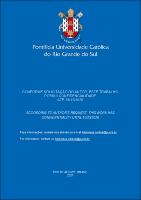| Share record |


|
Please use this identifier to cite or link to this item:
https://tede2.pucrs.br/tede2/handle/tede/10036| Document type: | Dissertação |
| Title: | Avaliação em modelos digitais da forma do arco maxilar em pacientes classe II tratados ortodonticamente |
| Author: | Meller, Cecilia Romero  |
| Advisor: | Lima, Eduardo Matinelli Santayana de |
| Abstract (native): | O objetivo deste estudo foi analisar em modelos digitais as mudanças ocorridas nas formas das arcadas dentárias maxilares em pacientes Classe II tratados ortodonticamente. A amostra experimental consistiu em 20 pacientes classe II que foram tratados ortodonticamente. Os pacientes foram classificados de acordo com o padrão de crescimento, para SN.GoGn ≤ 34º (Horizontais) e para SN.GoGn > 34º (Verticais). Um total de 40 modelos de estudo, 20 modelos iniciais (T0) e 20 modelos finais (T1), foram escaneados (iTero Element; Align Technology, San Jose, CA, USA) e analisados no software OrthoAnalyzer (3Shape, Copenhagen, Denmark). O Teste t pareado, foi utilizado para a comparação entre os grupos. Ocorreu aumento estatisticamente significativo da distância intercanina (p = 0,004) de T0 para T1. Houve um aumento do ângulo formado entre a linha média e caninos e segundos pré-molares, mas com significância estatística somente no lado direito (LM – 13/15 = 3,17 graus; p = 0,011) (LM – 23/25 = -3,45 graus; p = 0,086). Não houve diferença estatisticamente significativo da distância intermolares (p>0,05). O tratamento ortodôntico em pacientes classe II causou aumento significativo da distância intercanina assim como na região de pré-molares no arco maxilar. Não houve relação entre os indivíduos com faces hipodivergentes e hiperdivergentes. |
| Abstract (english): | The purpose of this study were to analyze in digital models the changes that occurred in the shape of the maxillary dental arches in Class II patients treated orthodontically. The sample consisted of 20 class II patients who were treated orthodontically. Patients were classified according to the growth pattern, for SN.GoGn ≤ 34º (Horizontal) and for SN.GoGn> 34º (Vertical). A total of 40 study models, 20 initial models (T0) and 20 final models (T1), were scanned (iTero Element; Align Technology, San Jose, CA, USA) and analyzed using the OrthoAnalyzer software (3Shape, Copenhagen, Denmark) . The paired t-test was used to compare the groups. There was a statistically significant increase in intercanine distance (p = 0.004) from T0 to T1. There was an increase in the angle formed between the midline and canines and second premolars, but with statistical significance only on the right side (LM - 13/15 = 3.17 degrees; p = 0.011) (LM - 23/25 = - 3.45 degrees; p = 0.086). There was no statistically significant difference in the intermolar distance (p> 0.05). Orthodontic treatment in class II patients caused a significant increase in intercanine distance as well as in the premolar region in the maxillary arch. There was no relationship between individuals with hypodivergent and hyperdivergent faces. |
| Keywords: | Forma do Arco Modelos de Estudo Má Eclusão de Angle Classe II Archform Study Models |
| CNPQ Knowledge Areas: | CIENCIAS DA SAUDE::ODONTOLOGIA |
| Language: | por |
| Country: | Brasil |
| Publisher: | Pontifícia Universidade Católica do Rio Grande do Sul |
| Institution Acronym: | PUCRS |
| Department: | Escola de Ciências Saúde e da Vida |
| Program: | Programa de Pós-Graduação em Odontologia |
| Access type: | Acesso Aberto |
| Fulltext access restriction: | Trabalho será publicado como artigo ou livro |
| Time to release fulltext: | 60 meses |
| Date to release fulltext: | 23/12/2026 |
| URI: | http://tede2.pucrs.br/tede2/handle/tede/10036 |
| Issue Date: | 5-Mar-2020 |
| Appears in Collections: | Programa de Pós-Graduação em Odontologia |
Files in This Item:
| File | Description | Size | Format | |
|---|---|---|---|---|
| DIS_CECILIA_ROMERO_MELLER_CONFIDENCIAL.pdf | CECILIA_ROMERO_MELLER_DIS | 363.88 kB | Adobe PDF |  Download/Open Preview |
Items in DSpace are protected by copyright, with all rights reserved, unless otherwise indicated.




